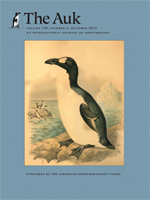The influence of vegetation structure on the probability of daily nest survival (DNS) for grassland passerines has received considerable attention. Some correlative studies suggest that the presence of woody vegetation lowers DNS. Over 3 years (2009–2011), we monitored 215 nests of the Grasshopper Sparrow (Ammodramus savannarum) and Henslow's Sparrow (A. henslowii) on 162 ha of reclaimed surface-mine grasslands in Pennsylvania. We removed shrubs from treatment plots with ≤36% areal coverage of woody vegetation in a before-after-control-impact-pairs (BACIP) design framework. Daily nest survival (95% CI: 0.94–0.96) was as high as previous studies have reported but was not associated with woody vegetative cover, proximity to woody vegetation, or woody stem density. Variation in DNS was best explained by increasing nonwoody-vegetation height. Grasshopper Sparrow fledgling production on treatment plots in 2010 (95% CI: 3.3–4.7) and 2011 (95% CI: 3.8–5.0) was similar to baseline conditions of treatmentplots (95% CI: 3.4–4.9) and control plots (95% CI: 3.2–4.5) in 2009. Fledgling production was associated with thatch depth (β ± SE = 0.13 ± 0.09) and bare ground (β ± SE = -2.62 ± 1.29) adjacent to the nest and plot woody vegetative cover ( ± SE = -3.09 ± 1.02). Our experimental research suggests that overall reproductive success of Grasshopper and Henslow's sparrows on reclaimed surfacemine grasslands is driven by a suite of largely nonwoody—vegetation components, and both species can successfully nest and produce young in habitats with greater amounts of scattered woody vegetation than has generally been considered.
± SE = -3.09 ± 1.02). Our experimental research suggests that overall reproductive success of Grasshopper and Henslow's sparrows on reclaimed surfacemine grasslands is driven by a suite of largely nonwoody—vegetation components, and both species can successfully nest and produce young in habitats with greater amounts of scattered woody vegetation than has generally been considered.
How to translate text using browser tools
1 October 2013
Experimental Removal of Woody Vegetation Does not Increase Nesting Success or Fledgling Production in Two Grassland Sparrows (Ammodramus) in Pennsylvania
Jason M. Hill,
Duane R. Diefenbach
ACCESS THE FULL ARTICLE

The Auk
Vol. 130 • No. 4
October 2013
Vol. 130 • No. 4
October 2013
Ammodramus
before-after-control-impact design
grassland birds
habitat alteration
nest survival
vegetation structure
woody vegetation




